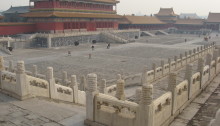The Imperial bedroom was the most popular scene in the Forbidden City. Crowds of tourists pressed their lenses up to the glass and peered in to see where the Emperor slept. The symbol on the far wall is “double happiness,” literally comprised of two happiness characters strung together. Many translations of Chinese into English happen to sound like Orwell’s 1984 “Newspeak.”
The exhibits were well curated with labels and often explanations for each artifact. Paintings or photographs served as the backdrop, artistically illustrating the objects in action. The largest exhibit was devoted to imperial marriages. This gold palanquin carried the bride into the Forbidden City. Before the marriage, a formal proposal event took place involving three phases: stating the proposal, requesting the woman’s full name and lineage to ensure there were no blood relatives in common, and an astrological process to check compatibility.
Many pages from the Emperor’s “wedding albums” were displayed on the museum walls. It was fascinating to recognize the architecture portrayed in the paintings from a few minutes prior to viewing them.
Lanterns such as the one above were lit for the arrival of the Empress-to-be through the gates of the Forbidden City at midnight. Once the Empress stepped over a saddle to enter the bridal chamber and the Emperor formally joined her, they proceeded to the bed and … ate underdone dumplings, literally. This special food was consumed on their marriage day to provide them with good male heirs. Drinking the nuptial cup was then the climax of the marriage.
Emerging from an indoor museum at the Forbidden City can best be described as walking out of the Medieval Art exhibit at the MET in NYC and unexpectedly finding yourself strolling through the corridors of a European castle. The more I wandered around this landmark, the more realistic it felt to my senses. The museum closed at 16:20, meaning there was an exodus of Chinese tourists moving toward the gates at 16:15, escaping the possibility of experiencing the palace after dark. At that time, crows came out to perch on the ornate eaves alongside the ceramic animals, and the palace really started to feel alive.






Enjoyed visiting your site, interesting article and some great photographs, Regards